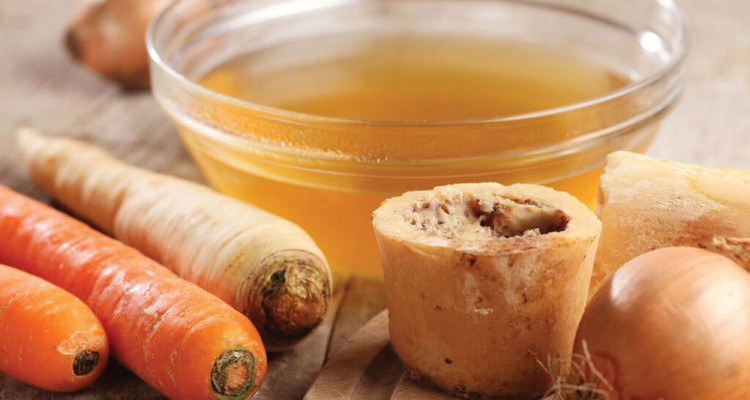Bone broth is
There is always spirited debate among athletes about the best components of supplementation and recovery. Should you go with something organic and homemade? Or will a scientifically engineered pill, vitamin, or powder suit your body better? One thing’s for certain: there are enough strong arguments on both sides to fill a playbook.
But what if grandma was right, and chicken soup really is all you needed to help your body heal, because of its natural goodness and chemical effects on your body?
Turns out, science is on her side, too. According to nutrition experts and medical professionals, chicken soup — or, more accurately, mineral-rich bone broth or stock — has many healing and recovery properties, along with performance-enhancing benefits ranging from short-circuiting a cold or flu virus to helping sports injuries heal.
But is there really science stirred in with the hype, or is it yet another fanatically doted-upon trend among fickle foodies and enthusiastic elites?
First, let’s break it down by first addressing what we know about the animal bones: Bone broth can be made from the bones of any animal, including cow, chicken, bison, wild game, or fish, which are very high in the amino acids proline and glycine when in liquid form, vital for healthy connective tissues.
Along with amino acids, the bones of healthy, free-range, and grass-fed animals are rich in collagen and gelatin, both of which soothe the intestinal tract and ease digestive issues. And collagen itself, the protein found in connective tissue of vertebrate animals, is abundant in bone, marrow, cartilage, tendons, and ligaments. And guess what? The breakdown of collagen in bone broths is what produces gelatin. Additionally, anti-inflammatories glucosamine and chondroitin — usually sold as expensive joint support supplements — are found in great supply in the marrow of these bones.
Related: Reviving Boring Chicken Breasts (And Reintroducing Thighs)
Basically, by making your own homemade bone broth, you’re saving yourself a trip to the pharmacy counter and saving some — wait for it — serious bones.
So, what are the drawbacks? Mainly the inconvenience. Bone broth cannot be purchased at the local supermarket, unfortunately. And, contrary to what you might believe, store-bought “broth” is really just meat-flavored product, full of MSG, sodium, and other “natural flavors.” Real, whole, honest-to-goodness broth takes a full 48 hours to make, and requires a slow cooker, your entire house smelling like a kitchen for a few days, and lots and lots of patience.
Now that you know that there was some science behind grandma’s greatest homemade remedy after all, how do you make your own? See the recipe below, and, dare I say it, ”bone” appétit!
Homemade Bone Broth
Ingredients:
· 2 pounds (or more) bones from a healthy source (most organic foods stores will have whole, free-range, roasted chicken or grass-fed, bone-in beef)
· 2 chicken feet for extra gelatin (optional)
· 1 onion
· 2 carrots, rough chopped
· 2 stalks of celery, rough chopped
· 2 tablespoons apple cider vinegar
· Optional: 1 bunch parsley, 1 tablespoon or more sea salt, 1 teaspoon peppercorns, additional herbs or spices to taste (I also add 2 cloves of garlic for the last 30 minutes of cooking).
You’ll also need a large stockpot to cook the broth in, and a strainer to remove the pieces when it is done. I usually aim for 2 pounds of bones per gallon of water I’m using to make broth. This usually works out to 2-3 full chicken carcasses. If possible I’ll also add 2 chicken feet per gallon of water (completely optional!).
Instructions:
If you are using raw bones, especially beef bones, roast them in the oven first to improve flavor (I place them in a roasting pan and roast for 30 minutes at 350 degrees). Then, place the bones in a large stockpot (I use a 5-gallon). Pour (filtered) water over the bones and add the vinegar. Let sit for 20-30 minutes in the cool water. The acid helps make the nutrients in the bones more available. Add the vegetables (except the parsley and garlic, if using) to the pot. Vegetables are actually optional too, but I find they add extra flavor and nutrition. Add any salt, pepper, spices, or herbs, if using. Bring the broth to a boil. Once it has reached a vigorous boil, reduce to a simmer and simmer until done. These are the times I simmer for:
· Beef broth/stock: 48 hours
· Chicken or poultry broth/stock: 24 hours
· Fish broth: 8 hours
During the first few hours of simmering, you’ll need to remove the impurities that float to the surface. A frothy/foamy layer will form and it can be easily skimmed off with a big spoon. Throw this part away. I typically check it every 20 minutes for the first 2 hours to remove this. Grass-fed and healthy animals will produce much less of this than conventionally raised animals.
During the last 30 minutes, add the garlic and parsley, if using. Then, remove from heat and let cool slightly. Strain, using a fine metal strainer to remove all bone and vegetable bits. When cool enough, store in a gallon-sized glass jar in the fridge for up to 5 days, or freeze for later use.
Looking for more food that will improve your health? Read on…
6 Delicious Foods for Glowing, Healthy Skin
New Study Reveals Avocado Health Secret: Good Fats Even Better Than You Thought

